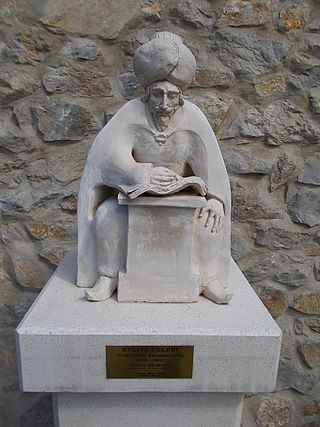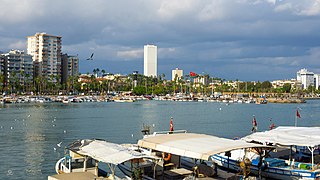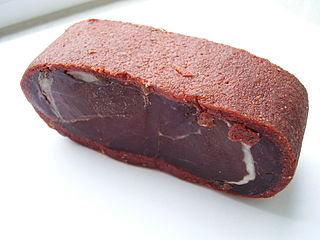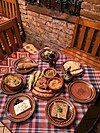
Dervish Mehmed Zillî, known as Evliya Çelebi, was an Ottoman explorer who travelled through the territory of the Ottoman Empire and neighboring lands during the empire's cultural zenith. He travelled for over 40 years, recording his commentary in a travelogue called the Seyahatnâme. The name Çelebi is an honorific meaning "gentleman" or "man of God".

Turkish cuisine is the cuisine of Turkey and the Turkish diaspora. Although the cuisine took its current rich form after numerous cultural interactions throughout centuries, it should not be confused with other cuisines such as Ottoman cuisine or Seljuk cuisine. Turkish cuisine with traditional Turkic elements such as yogurt, ayran, kaymak, exerts and gains influences to and from Mediterranean, Balkan, Middle Eastern, Central Asian and Eastern European cuisines.

A bagel is a bread roll originating in the Jewish communities of Poland. Bagels are traditionally made from yeasted wheat dough that is shaped by hand into a torus or ring, briefly boiled in water, and then baked. The result is a dense, chewy, doughy interior with a browned and sometimes crisp exterior.

Edirne, historically known as Adrianople is a city in Turkey, in the northwestern part of the province of Edirne in Eastern Thrace. Situated 7 km (4.3 mi) from the Greek and 20 km (12 mi) from the Bulgarian borders, Edirne was the second capital city of the Ottoman Empire from 1369 to 1453, before Constantinople became its capital.

Akhisar is a municipality and district of Manisa Province, Turkey. Its area is 1,645 km2, and its population is 177,419 (2022). It is the site of the ancient city of Thyatira.

Üsküdar is a municipality and district of Istanbul Province, Turkey. Its area is 35 km2, and its population is 524,452 (2022). It is a large and densely populated district on the Anatolian (Asian) shore of the Bosphorus. It is bordered to the north by Beykoz, to the east by Ümraniye, to the southeast by Ataşehir and to the south by Kadıköy; with Karaköy, Kabataş, Beşiktaş, and the historic city center of Fatih facing it on the opposite shore to the west. Üsküdar has been a conservative cultural center of the Anatolian side of Istanbul since Ottoman times with its numerous historic landmark and little mosques and dergahs.

Urmia or Orumiyeh is the largest city in West Azerbaijan Province of Iran. In the Central District of Urmia County, it is capital of the province, the county, and the district.

Mersin is a large city and port on the Mediterranean coast of southern Turkey. It is the provincial capital of the Mersin Province. It is made up of four district governorates, each having its own municipality: Akdeniz, Mezitli, Toroslar and Yenişehir.

Pastirma or Pasterma, also called pastarma,pastırma,pastourma, basdirma, basterma, basturma, or aboukh is a highly seasoned, air-dried cured beef that is found in the cuisines of Albania, Armenia, Romania, Bulgaria, Egypt, Greece, Cyprus, Iraq, the Levant, North Macedonia, Azerbaijan, and Turkey.

Büyükada, meaning "Big Island" in Turkish, is the largest of the Princes' Islands in the Sea of Marmara, near Istanbul, with an area of about 2 square miles. It is made up of the Maden and Nizam neighbourhoods in the Adalar (Islands) district of Istanbul Province, Turkey.

A flatbread is bread made usually with flour; water, milk, yogurt, or other liquid; and salt, and then thoroughly rolled into flattened dough. Many flatbreads are unleavened, although some are leavened, such as pita bread.

Bourekas or burekas are a popular baked pastry in Sephardic Jewish cuisine and Israeli cuisine. A variation of the burek, a popular pastry throughout southern Europe, northern Africa and the Middle East, Israeli bourekas are made in a wide variety of shapes and a vast selection of fillings, and are typically made with either puff pastry, filo dough, or brik pastry, depending on the origin of the baker.
The city of Istanbul has been known by a number of different names. The most notable names besides the modern Turkish name are Byzantium, Constantinople, and Stamboul. Different names are associated with different phases of its history, with different languages, and with different portions of it.

Ottoman cuisine is the cuisine of the Ottoman Empire and its continuation in the cuisines of Greece, Turkey, the Balkans, Caucasus, Middle East and Northern Africa.

Ashure, Anoushabour, Noah's pudding or Trigo koço is a sweet pudding of that is made of a mixture consisting of various types of grains, fresh and dried fruits, and nuts.

Baklava is a layered dessert made of filo pastry sheets, filled with chopped nuts, and sweetened with syrup or honey.

Bankalar Caddesi, also known as Voyvoda Caddesi, in the historic Galata quarter of the district of Beyoğlu (Pera) in Istanbul, Turkey, was the financial centre of the late Ottoman Empire. It strikes out west from busy Kemeraltı Caddesi in Karaköy and segues into Okçu Musa Caddesi which leads up to Şişhane and Tepebaşı in Beyoğlu.

Tunceli Province, formerly Dersim Province, is a province in the Eastern Anatolia Region of Turkey. Its central city is Tunceli.The province has eight municipalities, 366 villages and 1,087 hamlets.

The Old Bridge, also known as the Old Tigris Bridge, is a ruined four-arch bridge spanning the Tigris River in the town of Hasankeyf in Batman Province in southeastern Turkey. It was built by the Artuqid Turkmens in the mid-12th century, between about 1147 and 1167, and at the time its central arch was one of the largest in the world, if not the largest. The bridge was repaired by Ayyubid Kurdish and Aq Qoyunlu Turkmen rulers during the 14th and 15th centuries and appears to have eventually collapsed in the early or mid-17th century. The bridge's ruined piers still stand, as does one arch. Since 2020 the ruins of the bridge, along with most of the town of Hasankeyf, have been submerged underwater by the filling of the Ilısu Dam reservoir.
Ayşe Sultan was an Ottoman princess, daughter of Sultan Ahmed I and Kösem Sultan, half-sister of Sultan Osman II and sister of Sultan Murad IV and Sultan Ibrahim of the Ottoman Empire. Ayşe is known for her many politically motivated marriages.
























